
No matter how much you try to plan your life, you can't avoid the curve balls that come your way and throw you for a loop. And 2020 has been filled with endless loops. There have been so many that even those who think a predictable life is a boring life may be craving stability.
Since nobody can forecast when life will return to normal — or if the "new normal" will even seem like normal — it can be helpful to learn to embrace uncertainty. This will not only benefit you until the COVID-19 pandemic is over, but it will also help you cope with all the unpredictability that shows up in your life for years to come.
Video of the Day
Video of the Day
And one way to learn to welcome instability is through a yoga practice.
Check out more of our 20-minute workouts here — we've got something for everyone.
How Yoga Helps With Uncertainty
"Embracing uncertainty requires a shift of perspective," says yoga instructor Tiffany Cruikshank, E-RYT, founder of Yoga Medicine®. "This could mean welcoming obstacles as challenges and opportunities to grow, or it could mean finding that familiar place inside of you that is always with you — an anchor like the breath that you can come home to at any time."
By spending time on a yoga mat, you can practice facing difficult poses and transitions, in turn building up your confidence to face hurdles off the mat. You can also practice coming back to your breath and trying to keep it steady throughout your flow, whether you're in Child's pose or attempting Crow pose.
When you focus on your inhalations, exhalations and any sensations that come up during a yoga sequence, you retrain your brain.
"We train our nervous system to shift away from automatic thoughts that, in times of uncertainty, tend to lean toward fear and anxiety, and shift toward a sense of curiosity in our moment-to-moment experience," Cruikshank explains. "This recalibrates our perspective and anchors us in the moment," rather than ruminating about the past or attempting to predict the future, both of which can happen in times of distress.
A 20-Minute Yoga Flow to Help Embrace Uncertainty
"With uncertainty all around us, finding ways to find steadiness this season is paramount," Cruikshank says.
The main objective of the practice she shares below is to welcome whatever sensations or experiences come up along the way with a sense of curiosity. As you move from pose to pose, try to simply notice your breath and the sensations that come.
Move 1: Breathwork
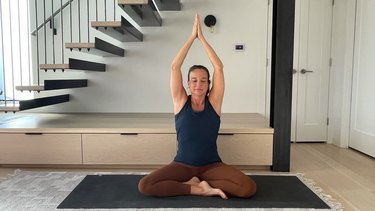
- Begin in a comfortable seated position. Inhale as you lift your arms overhead.
- Keep your mouth closed and exhale, creating an “Mmmmm” sound (like a buzzing bee) as you fold forward to a comfortable depth and lower your arms by your sides.
- Repeat for 2 to 3 minutes.
Tip
The key to this pose is to find an easy, comfortable movement as you focus on slowing down the exhale by creating the sound.
Move 2: Seated Fold

- Find a comfortable seat with your hips up on a blanket or two and your shins crossed in front of you.
- Exhale and walk your hands out in front of you to a gentle stretch.
- Focus your attention on the sensations and breathe here, allowing yourself to tap into an introspective curiosity.
- Stay in this position for 1 to 2 minutes.
- Switch the cross of the shins and repeat on the other side.
Move 3: Tree
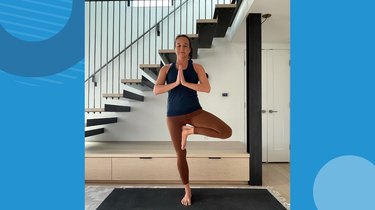
- Start standing and shift your weight onto your right foot as you lift your left foot to your inner calf or inner thigh. Press your right leg and left foot into each other as you lift out of your pelvis. Keep your hands in prayer by your chest.
- Stay for 5 to 8 breaths with a sense of curiosity to your balance here. Is it easy or more challenging today? Allow yourself to notice without the need to change or interpret it.
- Repeat on the other side.
Tip
If you want some extra support, stand near a wall, but try not to lean on the wall.
Move 4: Warrior II
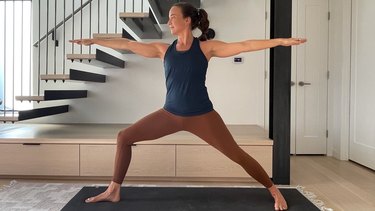
- Start standing and step your left foot back in line with your right, like you’re walking a tight rope.
- With your right toes pointing forward, turn your left toes out and bend your right knee. Extend your arms out to the sides, reaching for the front and back walls.
- Feel the strength and steadiness of your legs and pelvis here as you stay for 30 to 60 seconds.
- Repeat on the other side.
Move 5: Half-Moon
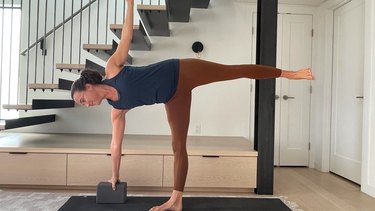
- From Warrior II with your right knee bent, reach your right hand forward toward the floor in front of you.
- Lift your left leg up behind you as you roll your torso open to the left side of your mat. Lift your left arm up, pointing your fingers toward the ceiling.
- Stay for 3 to 5 breaths.
- Repeat on the other side by coming to Warrior II with your left knee bent.
Tip
For some extra support with half moon pose, you can grab a yoga block and use it to help lift your torso up. Or for a challenge, see if you can hover your bottom hand off the floor. Notice how your belief in your capacity here can shift daily and also influence your balance. See if you can tap into a sense of inner steadiness that is always with you as a mindset.
Move 6: Bridge Lift
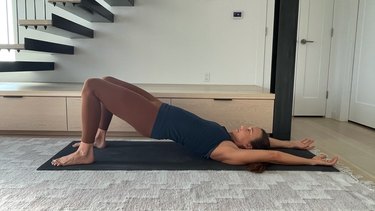
- Lie on your back with your knees bent and feet about hip-width apart.
- On an inhale, peel your spine up off the floor as you lift your arms overhead.
- On an exhale, slowly lower one vertebra at a time as you lower your arms to the sides. Focus on slowing down the exhalation as you deflate and lower to the floor, triggering the relaxation response connected to the exhale.
- Repeat for 1 to 2 minutes.
Move 7: Body Scan
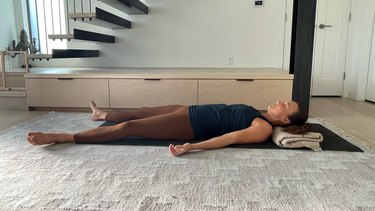
- Lie on the floor in a comfortable position. Close or soften your eyes and allow your breath to move in its own time.
- With a sense of curiosity, start to scan your body, beginning at your head and slowly making your way down to your feet. Note the temperature, weight and sensations, as well as areas that feel less sensation or any emotions or other qualities there. Allow yourself to simply notice.
- Continue with the body scan for at least 5 minutes. Linger for longer, if you wish.
- When you’re done, give yourself a couple of minutes to sense a settling into yourself, or a feeling of coming home. See if you can sense a source of inner steadiness that is always there, perhaps the consistency of your breath or the reliability of your heartbeat.
Tip
You can use a pillow for your head, support for behind the knees or perhaps a blanket for warmth.